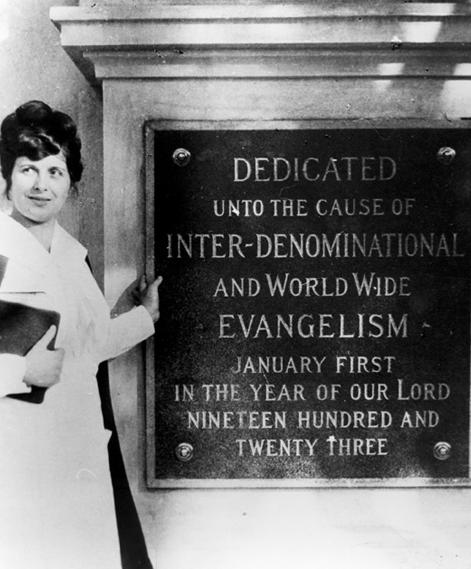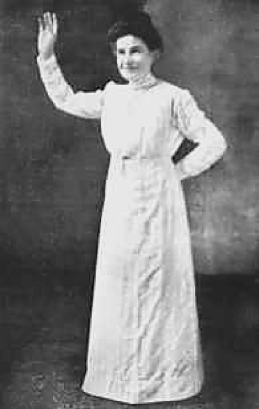Pioneer Women of Pentecostal Revivals
PneumaReview.com: How important was it for early Pentecostal women, or at least women preachers, to negotiate the stereotypes expected of them?

Aimee Semple McPherson with the dedication plaque for Angelus Temple.
Leah Payne: Negotiating (and even heightening) gender stereotypes was key for early Pentecostal women. Women ministers had to show that they were womanly enough to be respectable women and authoritative enough to wield power as ministers. This was quite the tightrope to walk! Women ministers tried different ways of embodying their womanliness and their ministries, but the most successful women usually took on an identity as a minister that corresponded to an ideal form of womanhood in the late nineteenth and early twentieth centuries. Stereotypical versions of womanliness abound in any era, but there was no stereotypical authoritative female minister, so that was where the women had to get really creative.
PneumaReview.com: How do you think Woodworth-Etter and McPherson would be received today? What can we learn from them and other women revivalists of their era?
Leah Payne: Women celebrity ministers like Paula White, Juanita Bynum, or Joyce Meyer, who – self-consciously or not – imitate Woodworth-Etter and McPherson demonstrate how they would probably be received. Some love and support them; others believe they are fraudulent, disobedient to God, or just plain ridiculous. I guess that there would not be a lot of middle ground. As it is with many celebrity revivalist preachers (from Creflo Dollar to Mark Driscoll), they are usually either loved or hated.
We can learn several things from Woodworth-Etter, McPherson, and other women of the era. First, they show us the kind of toughness, smarts, and creativity women ministers needed in order to succeed in the “man’s world” of the ministry. They also teach us that Pentecostalism held within it the theological and practical flexibility needed in order to have authoritative female ministers (for more on this, read Gender and Pentecostalism!). In addition, women revivalists of the era show us that gender – even gender in the late nineteenth and early twentieth centuries – is a dynamic construct. Even when it seems like the categories of woman and man are rock solid, these women demonstrate that there is always wiggle room! Woodworth-Etter and McPherson also remind us that a radical experience with the Holy Spirit can transcend pretty much any earthly barrier. And that’s just the beginning! I hope that others will continue to study these women and their legacies.
PneumaReview.com: How are the issues today different from what Woodworth-Etter and McPherson faced?

Maria Woodworth-Etter
Leah Payne: In many ways, the more things change, the more they stay the same. Women in any positions of power continue to wrestle with how to maintain their legitimacy as women, while at the same time creating and exercising authority. The specifics around what makes an ideal woman have changed, but the pressure to be one remains. Today, as in the early twentieth century, women leaders are generally not well received in churches or in American culture at large. On the other hand, today’s women have more access to theological education, they have made undeniable progress in leadership roles outside the church, and there are more opportunities for women to network with one another than there have ever been.
Category: Church History, Summer 2016


